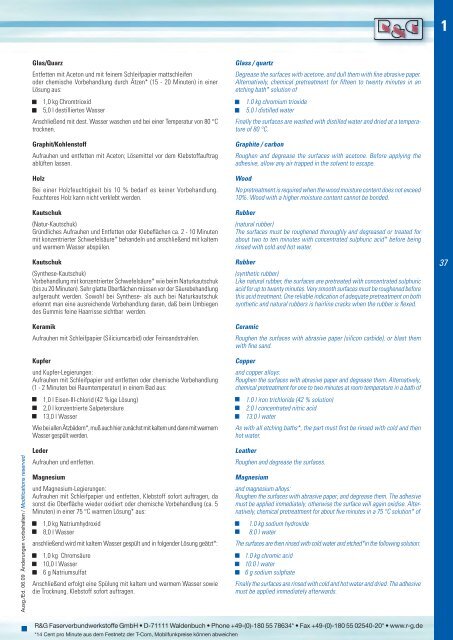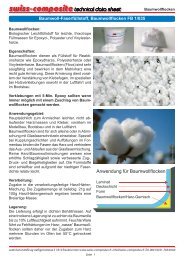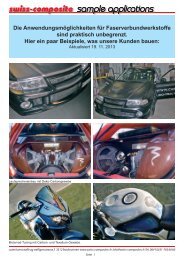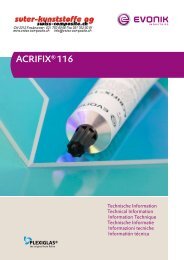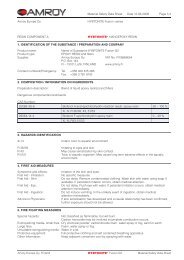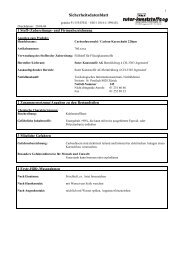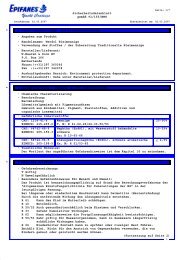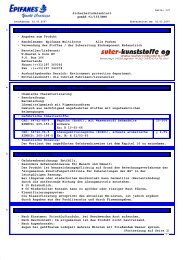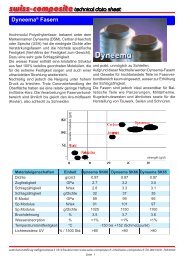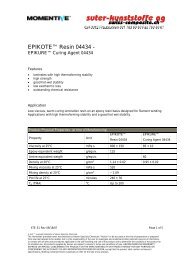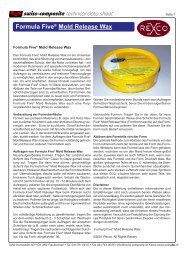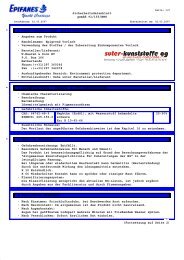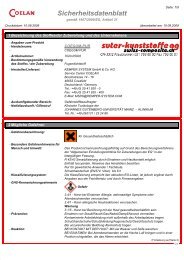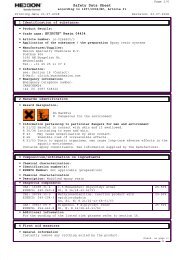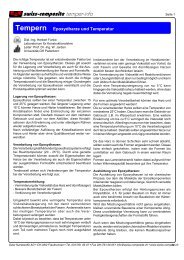1 - Suter Swiss-Composite Group
1 - Suter Swiss-Composite Group
1 - Suter Swiss-Composite Group
Sie wollen auch ein ePaper? Erhöhen Sie die Reichweite Ihrer Titel.
YUMPU macht aus Druck-PDFs automatisch weboptimierte ePaper, die Google liebt.
Ausg./Ed. 06.09 Änderungen vorbehalten / Modifications reserved<br />
Glas/Quarz<br />
Entfetten mit Aceton und mit feinem Schleifpapier mattschleifen<br />
oder chemische Vorbehandlung durch Ätzen* (15 - 20 Minuten) in einer<br />
Lösung aus:<br />
1,0 kg Chromtrioxid<br />
5,0 l destilliertes Wasser<br />
Anschließend mit dest. Wasser waschen und bei einer Temperatur von 80 °C<br />
trocknen.<br />
Graphit/Kohlenstoff<br />
Aufrauhen und entfetten mit Aceton; Lösemittel vor dem Klebstoffauftrag<br />
ablüften lassen.<br />
Holz<br />
Bei einer Holzfeuchtigkeit bis 10 % bedarf es keiner Vorbehandlung.<br />
Feuchteres Holz kann nicht verklebt werden.<br />
Kautschuk<br />
(Natur-Kautschuk)<br />
Gründliches Aufrauhen und Entfetten oder Klebeflächen ca. 2 - 10 Minuten<br />
mit konzentrierter Schwefelsäure* behandeln und anschließend mit kaltem<br />
und warmem Wasser abspülen.<br />
Kautschuk<br />
(Synthese-Kautschuk)<br />
Vorbehandlung mit konzentrierter Schwefelsäure* wie beim Naturkautschuk<br />
(bis zu 20 Minuten). Sehr glatte Oberflächen müssen vor der Säurebehandlung<br />
aufgerauht werden. Sowohl bei Synthese- als auch bei Naturkautschuk<br />
erkennt man eine ausreichende Vorbehandlung daran, daß beim Umbiegen<br />
des Gummis feine Haarrisse sichtbar werden.<br />
Keramik<br />
Aufrauhen mit Schleifpapier (Siliciumcarbid) oder Feinsandstrahlen.<br />
Kupfer<br />
und Kupfer-Legierungen:<br />
Aufrauhen mit Schleifpapier und entfetten oder chemische Vorbehandlung<br />
(1 - 2 Minuten bei Raumtemperatur) in einem Bad aus:<br />
1,0 l Eisen-III-chlorid (42 %ige Lösung)<br />
2,0 l konzentrierte Salpetersäure<br />
13,0 l Wasser<br />
Wie bei allen Ätzbädern*, muß auch hier zunächst mit kaltem und dann mit warmem<br />
Wasser gespült werden.<br />
Leder<br />
Aufrauhen und entfetten.<br />
Magnesium<br />
und Magnesium-Legierungen:<br />
Aufrauhen mit Schleifpapier und entfetten, Klebstoff sofort auftragen, da<br />
sonst die Oberfläche wieder oxidiert oder chemische Vorbehandlung (ca. 5<br />
Minuten) in einer 75 °C warmen Lösung* aus:<br />
1,0 kg Natriumhydroxid<br />
8,0 l Wasser<br />
anschließend wird mit kaltem Wasser gespült und in folgender Lösung geätzt*:<br />
1,0 kg Chromsäure<br />
10,0 l Wasser<br />
6 g Natriumsulfat<br />
Anschließend erfolgt eine Spülung mit kaltem und warmem Wasser sowie<br />
die Trocknung. Klebstoff sofort auftragen.<br />
R&G Faserverbundwerkstoffe GmbH • D-71111 Waldenbuch • Phone +49-(0)-180 55 78634* • Fax +49-(0)-180 55 02540-20* • www.r-g.de<br />
*14 Cent pro Minute aus dem Festnetz der T-Com, Mobilfunkpreise können abweichen<br />
Glass / quartz<br />
Degrease the surfaces with acetone, and dull them with fine abrasive paper.<br />
Alternatively, chemical pretreatment for fifteen to twenty minutes in an<br />
etching bath* solution of<br />
1.0 kg chromium trioxide<br />
5.0 l distilled water<br />
Finally the surfaces are washed with distilled water and dried at a temperature<br />
of 80 °C.<br />
Graphite / carbon<br />
Roughen and degrease the surfaces with acetone. Before applying the<br />
adhesive, allow any air trapped in the solvent to escape.<br />
Wood<br />
No pretreatment is required when the wood moisture content does not exceed<br />
10%. Wood with a higher moisture content cannot be bonded.<br />
Rubber<br />
(natural rubber)<br />
The surfaces must be roughened thoroughly and degreased or treated for<br />
about two to ten minutes with concentrated sulphuric acid* before being<br />
rinsed with cold and hot water.<br />
Rubber<br />
(synthetic rubber)<br />
Like natural rubber, the surfaces are pretreated with concentrated sulphuric<br />
acid for up to twenty minutes. Very smooth surfaces must be roughened before<br />
this acid treatment. One reliable indication of adequate pretreatment on both<br />
synthetic and natural rubbers is hairline cracks when the rubber is flexed.<br />
Ceramic<br />
Roughen the surfaces with abrasive paper (silicon carbide), or blast them<br />
with fine sand.<br />
Copper<br />
and copper alloys:<br />
Roughen the surfaces with abrasive paper and degrease them. Alternatively,<br />
chemical pretreatment for one to two minutes at room temperature in a bath of<br />
1.0 l iron trichloride (42 % solution)<br />
2.0 l concentrated nitric acid<br />
13.0 l water<br />
As with all etching baths*, the part must first be rinsed with cold and then<br />
hot water.<br />
Leather<br />
Roughen and degrease the surfaces.<br />
Magnesium<br />
and magnesium alloys:<br />
Roughen the surfaces with abrasive paper, and degrease them. The adhesive<br />
must be applied immediately, otherwise the surface will again oxidise. Alter-<br />
natively, chemical pretreatment for about five minutes in a 75 °C solution* of<br />
1.0 kg sodium hydroxide<br />
8.0 l water<br />
The surfaces are then rinsed with cold water and etched*in the following solution:<br />
1.0 kg chromic acid<br />
10.0 l water<br />
6 g sodium sulphate<br />
Finally the surfaces are rinsed with cold and hot water and dried. The adhesive<br />
must be applied immediately afterwards.<br />
1<br />
3


